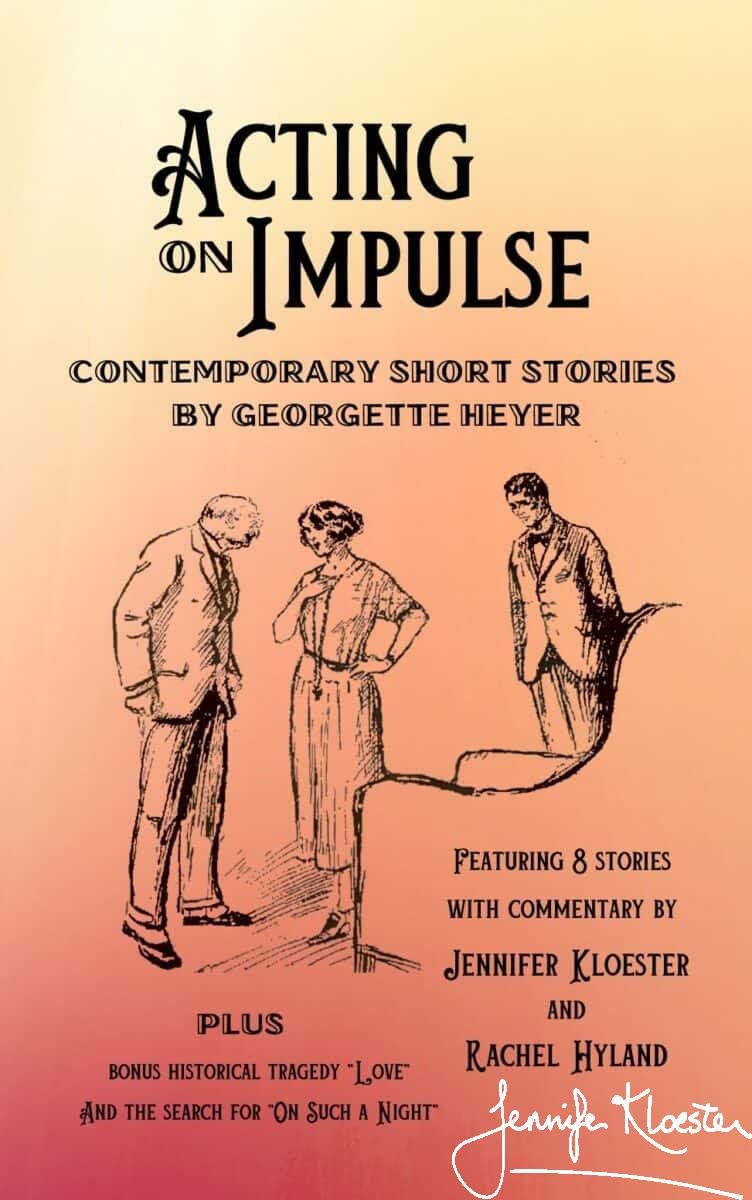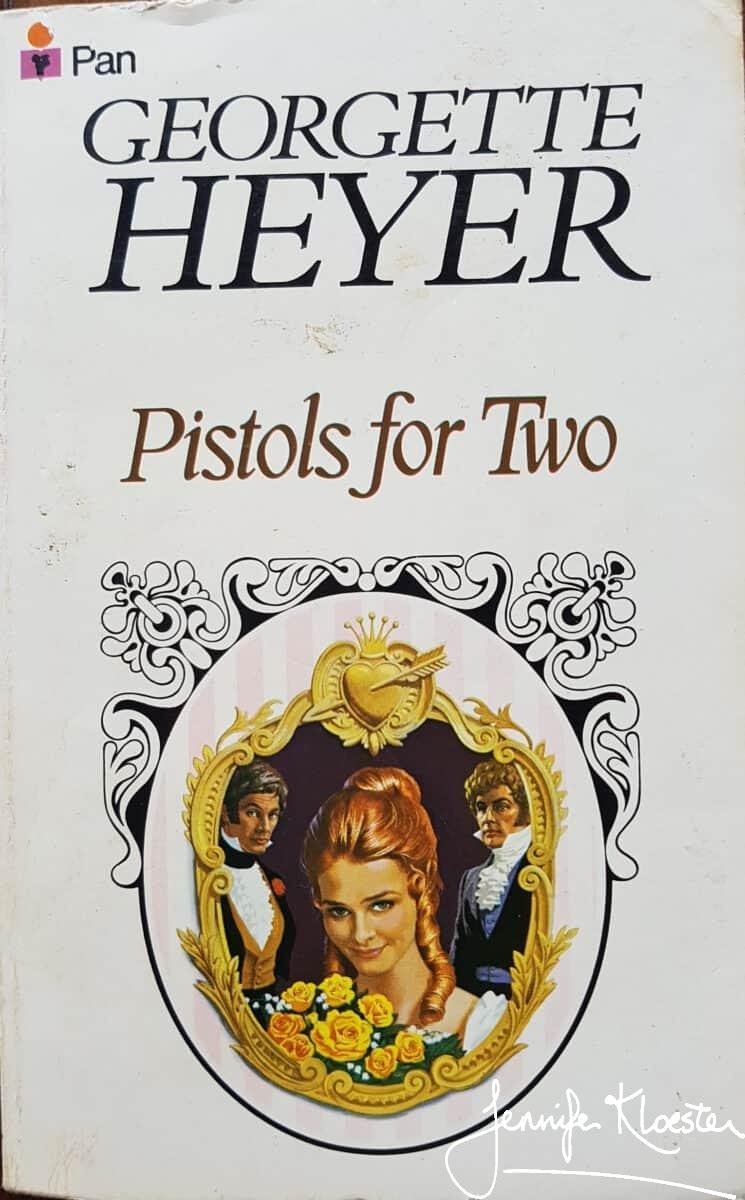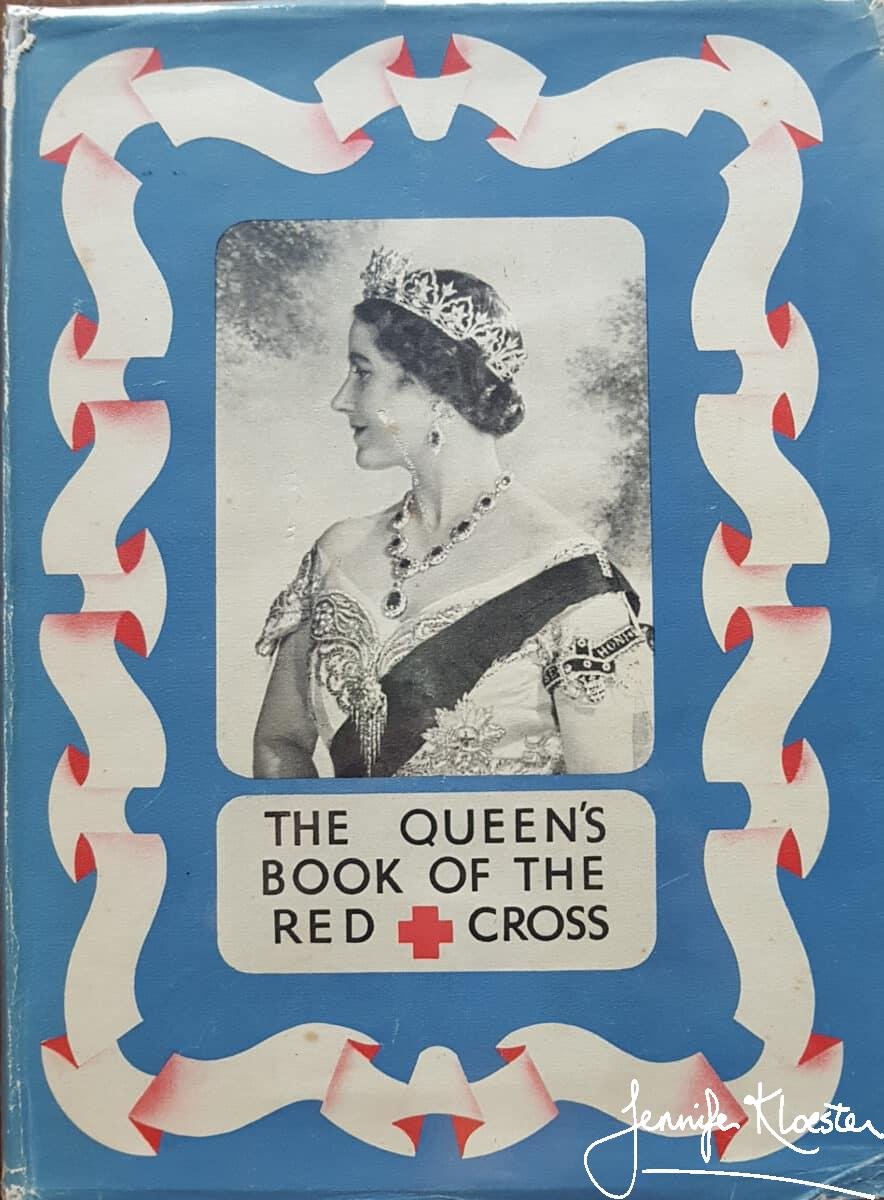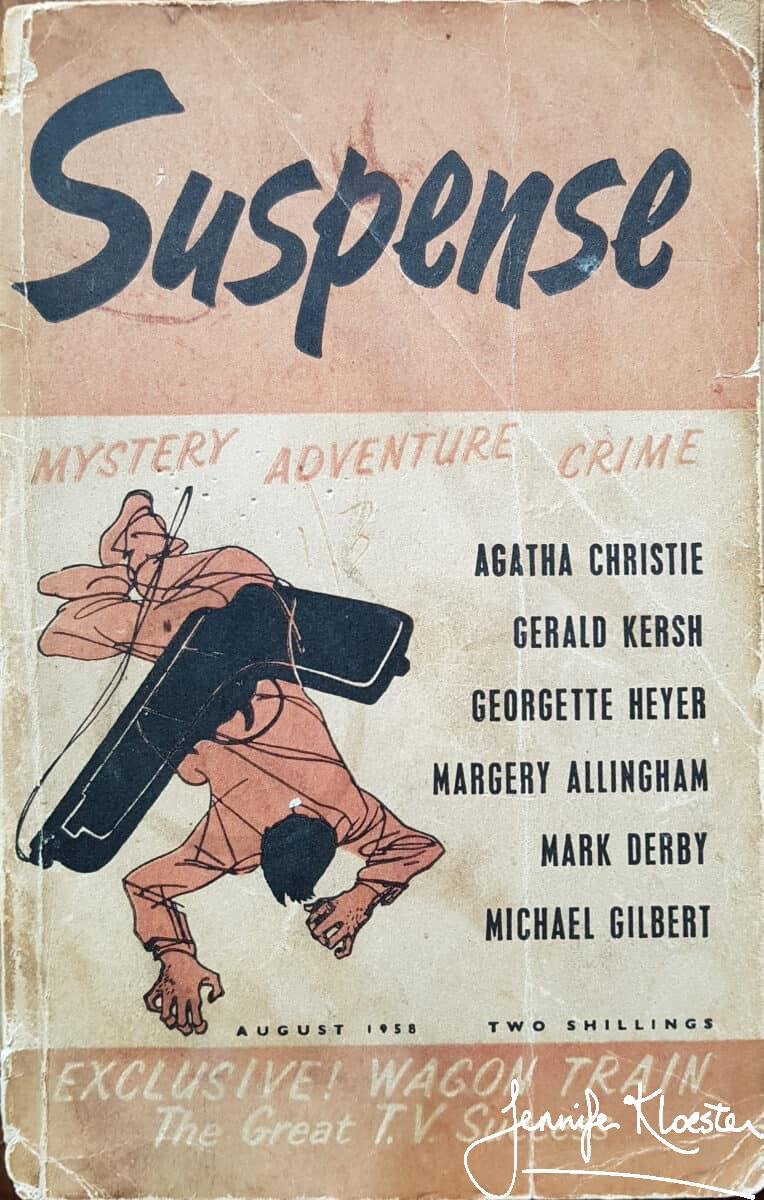
A compulsive writer
A compulsive writer and storyteller, Georgette Heyer began making up stories in early childhood. She was an imaginative child and storytelling came as naturally to her as breathing. While her first novel was written at the age of seventeen, she had made up stories long before that. A friend of her schooldays vividly remembered Saturdays spent with Georgette at the Heyer’s house in Wimbledon. Georgete would make up stories full of excitement and adventure and they would act them out “all dialogue completely impromptu, of course, but the plots always produced by Georgette.” Reading Georgette’s novels years later, the plots of The Black Moth, The Masqueraders, and Beauvallet, in particular, leapt out at her old old friend who recognised from those long-ago days of play-acting in the Heyer’s drawing room. Georgette’s first known published short story was the delightful contemporary tale entitled “A Proposal to Cicely”. It was published in 1922 in The Red Magazine and was swiftly followed by the sentimental and almost supernatural, “The Little Lady”. Half a dozen more contemporary short stories followed until, in 1925, she wrote her final modern short, “The Old Maid” – her second publication under her pseudonym of “Stella Martin”. In 2019, with permission from the Heyer Estate, these nine short stories were collected into a new anthology and with an Introduction and an Afterword to each story was published under the title, Acting on Impulse
Something about Georgette
Each story tells us something about Georgette Heyer, about her development as a writer, her willingness to experiment, her ear for the language of the day, her attitudes to women and marriage, her attempts to write in different genres and her perception of love and relationships. These stories represent her juvenilia – they are not her best work, but nor should they remain unseen by modern readers. Georgette was writing for money and for experience. She was working out her voice and trying her hand at different styles. These early stories, along with her early novels, helped build Heyer’s writing “muscle” and were an important part of her evolution as an author. They are also interesting, entertaining stories, reflective of their time and place. Even at twenty, Georgette Heyer was a good writer, and her earliest short stories reveal much of the superb stylist she was learning to be. In April 1936 she published her first known historical short story, “Runaway Match”. It appeared in the prestigious and incredibly popular, Woman’s Journal, and was quickly followed in May by “Incident on the Bath Road” and then, in June, “Hazard” appeared. Over the next twenty-five years, Georgette would occasionally turn her hand to another historical short story. She wrote them easily and they made her good money for just a few hours work. Eventually, they would form the bestselling anthology, Pistols for Two.

1960 – another rare year without a book (almost)
1960 was to be another of Georgette’s rare years without a book – almost! Although 1959 had begun well with Georgette finishing The Unknown Ajax in great style and Ronald being made a Queen’s Counsel in March, the second half of the year was not easy. Her mother, Sylvia, had ‘little thrombosic [sic] attacks’ (she had a tendency to black out) and more than once Georgette had been called to the hospital to collect her from the Casualty Ward after “Mama” had fainted in the street. It was a constant source of worry, especially as Sylvia, having finally been persuaded to hire a companion, still insisted on venturing out alone whenever she could. Her mother was nearly eight-four and as strong willed and stubborn as ever. Georgette continued to support and visit her but their relationship would always be difficult and it is unlikely that either woman possessed the skill to resolve the issues that lay between them. A few years later, when Sylvia died, Georgette would be devastated and “strangely lost”. For now, however, she had to do her best to manage her mother’s and her own health issues while trying to think of a new novel for 1960 publication. In September 1959 she found a lump in her breast. Surgery followed on 16 October and she was glad to report that “the small, sordid job was done yesterday, & I hope & believe that that’s the end”. The tumour proved to be benign and, recovering in a private hospital, Georgette found herself feeling “rather limp, but enjoying a life of cushioned ease, with no one wanting me to do anything about anything!” She still suffered from digestive problems and needed further x-rays, but was comforted by her doctor’s reassurance that she would require no further surgery. But these challenges meant that she still had not written her new novel. By now her fans had come to expect their annual “Georgette Heyer” and so it was with relief that she accepted her agent, Joyce Weiner’s suggestion that she publish an anthology of her short stories. Georgette was so grateful to Joyce for the idea and for the ensuing success of Pistols for Two that she arranged for Joyce to receive ten per cent of the royalties from the book for her lifetime.

Pistols for Two
Short stories must have been on her mind for Georgette had spent January 1960 “perpetrat[ing] a 10,000 word job for a new Woman’s magazine”. It was a welcome commission for Joyce Weiner had negotiated a fee of 500 guineas for the short. It was a very large sum but by now Georgette Heyer was a famous name and one known to sell magazines so it was not unexpected. Soon afterwards her selling power was further corroborated by “a blind offer of £1000 from Australian Associated Newspaper Services for the first Australian serial rights in my next period novel” and another £1200 to serialise five of her “really old” thrillers. In light of this, the idea for the anthology seemed a good one. Georgette combed through her records and chose eleven historical short stories, all of them previously published in a range of different magazines. Her earliest chosen short was the 1936 story “Hazard”, whereas the rest dated from 1948 onwards. She also included her latest short story – the one she had written for the new – and as yet undiscovered – British magazine. It was called “A Clandestine Affair” and she described it as “very old rope – badly frayed” as well as “an unblushing crib on the works of Georgette Heyer”. It was an apposite description for the story, though lively and entertaining, had clear echoes of her 1955 novel, Bath Tangle. Georgette had recast Ivo Rotherham as George, Lord Iver, and Lady Selina as Miss Elinor Tresilian, added a young couple determined to wed in the face of their elders’ opposition, put in some heated dialogue, and sent them all off on a wild chase along the Great North Road. It was to be her last short story.

The Queen’s Book of the Red Cross was a fundraising project in 1940 
Georgette Heyer was among many noted authors invited to contribute.
The Queen’s Book of the Red Cross
One of the stories which Georgette did not include in the new anthology was “Pursuit” which she had originally written in 1939 for The Queen’s Book of the Red Cross. This was a fund-raising anthology supported by Queen Elizabeth (not the present Queen but her mother, the wife of King George VI and later the Queen Mother) to be published by Georgette’s publisher, Hodder & Stoughton. Her Majesty wrote a foreword praising the “noble work of the Red Cross” and the men and women of the Empire “fighting to defend its liberty”. It was to appear in time for Christmas with all proceeds going to one of the Queen’s favourite charities and Georgette was one of fifty “distinguished authors and artists” asked to donate their services. It is a mark of her growing fame that she was among those chosen to contribute to this special volume. The story, “Pursuit” is one of Georgette’s light-hearted Regency romances but for some reason she chose not to include it in Pistols for Two. The story would not be seen again by readers for more than sixty years.

To Have the Honour
In 1953, Good Housekeeping magazine asked Georgette to write a short story for their special Coronation edition at a price to be fixed by her new agent Joyce Weiner. King George VI had died in February and his elder daughter, Elizabeth, had been proclaimed Queen. Her coronation was to be held in June the following year and Georgette considered it rather an honour to be asked to write the lead story for the magazine’s special celebratory edition. It was without “an idea in my head” that she sat down to write it but, in spite of wondering why she had not “taken up charring, or something easy?” instead of writing, she eventually produced a spirited story entitled “The Pursuit of Hetty”. Seven years later, in Pistols for Two, this story would be renamed “To Have the Honour”. It would also become the seed story for her 1970 novel, Charity Girl.

The stunning 2016 Heinemann hardback edition of Snowdrift 
The equally gorgeous 2016 Arrow paperback edition of Snowdrift
Still selling
Sixty years after the publication of Pistols fo Two, Georgette Heyer is still selling. In 2016, in celebration of her enduring success her publishers brought out a new edition of the original short story anthology but with the addition of three of her long-forgotten historical short stories. With its beautiful cover Snowdrift and Other Stories came out in time for Christmas and readers who had been unaware of those early shorts were treated to “Incident on the Bath Road”, “Runaway Match” and “Pursuit”. The wonderful Mary Fahnestock-Thomas, who in 2001 had published her invaluable Georgette Heyer: A Critical Retrospective, had been aware of two of the shorts and been granted permission to include them in her book, but it had enjoyed only a limited (though much appreciated) circulation and “Incident on the Bath Road” had not been seen by readers since 1936. The new anthology continues to give reading pleasure to readers everywhere and has introduced many to the joys of Georgette Heyer.

The August 1958 edition of Argosy magazine 
Georgette’s dark short story proved very popular with readers.

The February 1972 edition of Argosy magazine 
The somewhat startling illustration for “Pink Domino”

Good company & Malice Domestic
Although Georgette did not write any more short stories (that we know of) after 1960, they continued to be published in various popular magazines such as Suspense and Argosy. Hers was a name to attract attention throughout the 1970s and she was regularly in the good company of other famous names such as Agatha Christie, Margery Allingham and others. Her dark Regency short story, “Night at the Inn” proved surprisingly popular with readers and after fading from sight for several years was republished in 2007 by Malice Domestic, the group who each year give out the Agatha Awards for crime writing in the tradition of Agatha Christie. The “Malice Domestic Pamphlets” are published
“To recognize the Ghost of Honour or the Lifetime Achievement Award recipient at Malice Domestic Conventions, Crippen & Landru has been privileged to issue pamphlets containing previously unpublished or little-known material. They are given to each person in attendance at the convention.”
Crippen & Landru, “Night at the Inn” by Georgette Heyer, The Ghost of Honour, Malice Domestic XIX May4-6 2007





